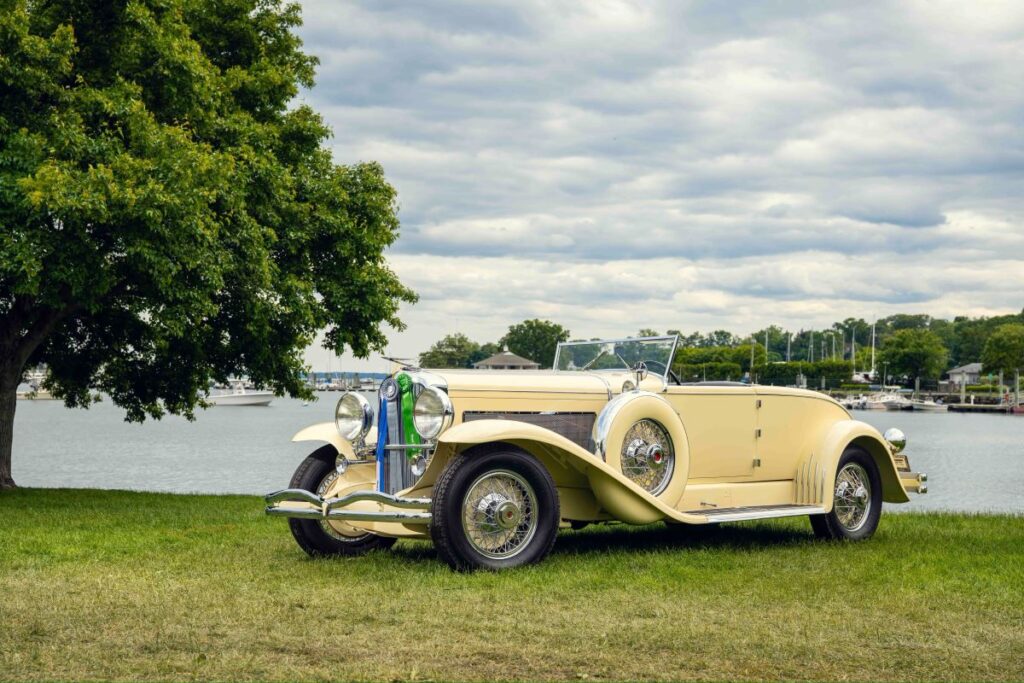
GREENWICH, Conn. (June 1, 2025) – After years of entering cars at the Greenwich Concours d’Elegance, prewar collector Tom Maoli’s wait is over. His 1932 Duesenberg Model J took Best in Show honors at the 2025 concours today, surpassing two gorgeous runners-up: a black 1937 Chrysler Imperial C-15 and a silver 1961 Ferrari 250 GT Speciale.
“It means a lot to win. We’ve done shows here over the last few years,” he said, celebratory champagne glass in hand. “To finally get across the finish line and get the monkey off our back is an honor. There’s nothing better.”
Maoli, of Mendham, New Jersey, has about 40 cars in his collection, including seven Duesenbergs. “Of them all, the Model J is my favorite. I think it’s the greatest car built in American history. The disappearing top version was one of the nicest.”
The so-called “disappearing top” is a custom modification that allows the brown convertible top and its associated mechanism to fully disappear into the Model J’s body. This particular example was among 25 bodied by Walter M. Murphy Co. of Pasadena, California. Other notable touches include Murphy’s signature “Clear-View” windshield pillars, mahogany running boards, full body-length chrome trim, 19-inch chrome wire wheels, and a rumble seat with accompanying steps.
When E.L. Cord bought the Duesenberg car company in 1925, his goal was to outdo Europe’s finest automakers, such as Rolls-Royce and Hispano-Suiza. That challenge, laid upon brothers Fred and August Duesenberg, produced the first Model J in 1928. It was a technological and engineering powerhouse positively oozing luxury. Its Lycoming-built straight-eight—whose block was painted bright green—displaced nearly 7 liters (420 cubic inches) and made 265 naturally aspirated horsepower. The engine was connected to a three-speed gearbox with a two-plate clutch. The eight-pot’s dual overhead cams and four valves per cylinder were so cutting-edge that the Model J churned out 80 more horsepower than the Cadillac V16 despite having half the cylinders.
As noted by the Museum of American Speed, the engine boasted aluminum connecting rods and pistons, a chrome-nickel steel crankshaft, and five main bearings. Cartridges 94 percent full of mercury, bolted to the crank cheek between cylinders one and two, were responsible for damping engine vibrations. As the museum explains, “the inertia of the mercury sloshing around in the cartridges was sufficient to absorb the torsional vibrations of the long crankshaft.”
The instrument panel was a showcase of the car’s advancement: tachometer, yes, but also altimeter-barometer, stopwatch-chronometer, a brake-pressure gauge, and four warning lights that dealt with everything from the state of chassis lubrication to intervals for fluid changes on the battery and engine.
Duesenberg’s advertising reflected its confidence in the achievement. “The only car that could pass a Duesenberg is another Duesenberg—and that was with the first owner’s consent,” read one particularly spicy bit of copy.
The chassis alone cost $8500, which equates to $159,000 today. With the body, they could cost $13,000 ($243,000 today) or, in some cases, much more. That the Duesenberg Model J managed to remain in production all the way until 1937—despite the fact that the car was introduced a mere eight months before the stock market crash of 1929—is a testament to its superlative status among the upper crust that made up its customer base. Fewer than 500 cars were built in total.
If the Model J’s 116-mph top speed wasn’t quite enough, Duesenberg also offered a centrifugal supercharger (such cars were dubbed “SJ”) that increased top speed to nearly 130 mph courtesy of 320 horsepower.
This car’s story began in 1932 when it was first delivered to Duesenberg’s Los Angeles hub. It didn’t sell there, so it was shipped to New York City, where JWY Martin of Maryland bought it. Martin was a prominent equestrian enthusiast who was active in both racing and polo. The car changed hands a number of times until 1962, when it got its red livery. Another restoration in 1970 added the factory supercharger and side-exit exhaust, both sourced from Model J number 401.
Other notable owners include General William “Bill” Lyons, who had it for more than 15 years. In 2012, collector Terry Adderly bought it and restored it over four years at Brian Joseph’s Classic and Exotic Service in Lachine, Michigan. Adderly had it painted in the current shade of cream.
Maoli bought the Model J about three years ago. All it needed was a bit of a tune-up: rebuilding the carburetors and replacing the points and condenser. According to the car’s build book, the owner is a “passionate car enthusiast who truly enjoys his vehicle beyond just admiring it. He regularly takes it on spirited drives, appreciating its performance and craftsmanship on the open road.”
According to collection manager Kevin Nickiel, Maori takes it to many shows and concours. If the event is within 50 or 100 miles, Maori will drive it there.
Nickiel is enthusiastic about the Model J, even in the context of the collection’s dozens of pristine vehicles. “They were the fastest, most expensive, most powerful vehicles of the time. As far as I’m concerned, none of the European automakers could tie Duesenberg’s shoes.”
At the Greenwich Concours today, the Model J’s shoelaces indeed proved untouchable.
Story by Eric Weiner
Photo courtesy Andrew Link
Leave a Reply
You must be logged in to post a comment.